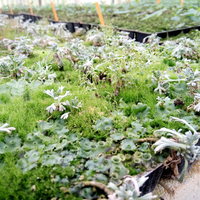Capnodis tenebrionis (L.) (Coleoptera Buprestidae) is one of the major pests of apricot and other stone-fruit trees in the Mediterranean basin, central and southern Europe, North Africa, and around the Black and Caspian Seas areas. This... more
Capnodis tenebrionis (L.) (Coleoptera Buprestidae) is one of the major pests of apricot and other stone-fruit trees in the Mediterranean basin, central and southern Europe, North Africa, and around the Black and Caspian Seas areas. This study was aimed at evaluating the influence of the rootstocks on the postembryonic development of the pest and emerged adults. Larvae were reared on semi-artificial substrates from the egg hatching to the pupa occurrence. The substrates differed only for the flour obtained from the bark of eight rootstocks (Adesoto, Cab6P, Colt, Garnem, GF677, MaxMa60, Montclar, Myrabolan 29C), selected among those more commonly used. For each treatment, weight increase of each larva, their survival, appearance time of pupae and adults’ size were recorded. Larval survival resulted the highest for GF677 treatments and the lowest for Colt and Adesoto. The biggest adults emerged from the substrate containing Montclar flour, whereas the smallest emerged from Adesoto and ...
Research Interests:
Research Interests:
Research Interests:
Research Interests: Plant Biology, Protein Structure and Function, Relative Growth Rate, Water use efficiency, Trees, and 12 moreOak, Forestry Sciences, Quercus ilex, Leaf Morphology, Air Temperature, Photosynthetic Rate, Leaf Anatomy, Leaf Area, Seedling Growth, Gas Exchange, Plasticity index, and Relative Water Content
ABSTRACT Since 2006, winter melon plants (Cucumis melo L. var inodorus) showing symptoms of pin-point yellow spots were noticed in Sicily (Italy). Leaf samples were tested by enzyme-linked immunosorbent assay to the most important... more
ABSTRACT Since 2006, winter melon plants (Cucumis melo L. var inodorus) showing symptoms of pin-point yellow spots were noticed in Sicily (Italy). Leaf samples were tested by enzyme-linked immunosorbent assay to the most important viruses-infecting cucurbits. Zucchini yellow fleck virus (ZYFV, genus Potyvirus) was the only virus detected. Surveys in 2007 and 2008 revealed an increasing number of sites in Sicily with ZYFV-infected winter melon plants. To confirm the identity of the virus as ZYFV, two isolates from different locations were sequenced and shown to be approximately 85% identical to the published sequences of isolates previously identified in Italy and France. This is the first report of ZYFV occurring on melon in Italy.
Research Interests:
Research Interests:
An improved protocol for efficient micropropagation was developed for azarole (Crataegus azarolus L.), a Mediterranean native species valuable for ornamental, fruit and medicinal purposes. Shoot cultures, established from axillary buds of... more
An improved protocol for efficient micropropagation was developed for azarole (Crataegus azarolus L.), a Mediterranean native species valuable for ornamental, fruit and medicinal purposes. Shoot cultures, established from axillary buds of adult tree, were multiplied on a modified LP medium supplied with 0.9, 1.8 or 3.6 µM BA, or CPPU. The highest axillary shoot multiplication was obtained on modified LP medium supplied with 1.8 µM BA. Concerning rooting, the highest percentage and number of roots was obtained with 19.6 µM IBA applied for 5 days or 392 µM IBA applied for 1 day. The subsequent transferring to a medium solidified with a mix of agar and vermiculite was retained for further improvement of the root system.
